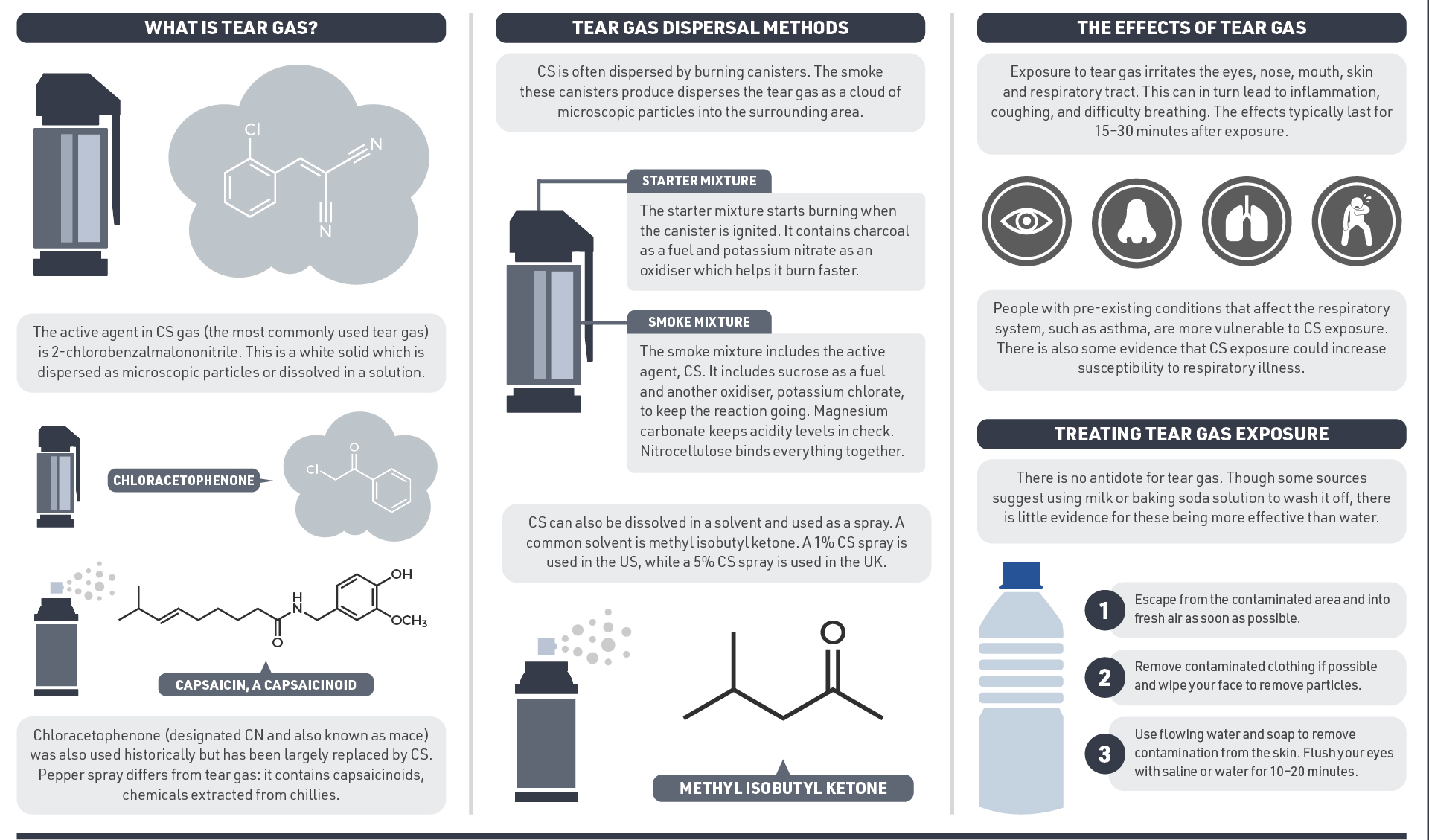- Home
- Prelims
- Mains
- Current Affairs
- Study Materials
- Test Series
 EDITORIALS & ARTICLES
EDITORIALS & ARTICLES
What is Tear Gas?
- Tear gas, also called lacrimator, is a group of substances that irritates the mucous membrane of the eyes. This causes a stinging sensation and tears. They may also irritate the upper respiratory tract, causing coughing, choking, and general debility (physical weakness). The effects of tear gases are temporary and reversible in most cases. Gas masks with activated charcoal filters provide good protection against them.
It was first used in World War I in chemical warfare, but since its effects are short-lasting and rarely disabling, it came into use by law-enforcement agencies as a means of dispersing mobs, disabling rioters, and flushing out armed suspects without the use of deadly force. - The substances most often used as tear gases are synthetic organic halogen compounds. They are not true gases under ordinary conditions but are liquids or solids that can be finely dispersed in the air through the use of sprays, fog generators, or grenades and shells.
- Compounds used in tear gas include Oleoresin Capsicum (OC, or pepper spray), bromoacetone, benzyl bromide, ethyl bromoacetate, xylyl bromide, α-bromobenzyl cyanide, chloropicrin, and chlorodihydrophenarsazine. The naturally occurring oleoresin capsicum (the major pungent component is Capsaicin) has also gained much attention in law enforcement and riot-control scenario. The two most commonly used tear gases are:
- 1-chloroacetophenone (CN)- is widely used in riot control which chiefly affects the eyes, and
- O-chlorobenzylidene malononitrile (CS)- is a stronger irritant that causes burning sensations in the respiratory tract and involuntary closing of the eyes.
- Cyanogen chloride (CNCl) is also a colorless and highly toxic liquefied gas that is soluble in water and organic solvents. It has a very irritating smell and it is denser than air. Cyanogen chloride causes severe irritation to the eyes and so for this reason it is used as a tear gas and has choking effects.
List of chemicals inside a tear gas canister
Charcoal - Usually made of wood heated until it's almost pure carbon. Pull the pin, and the fuse will set it smoldering: When combined with potassium nitrate, charcoal is easy to ignite.
Potassium nitrate - saltpeter, it gives off great quantities of oxygen when it burns, feeding the fire. Plants need potassium and nitrogen, so KNO3 has been used in fertilizer for centuries. The stuff used to come from bat poop or livestock pee, but today it can be made from ammonia.
Silicon - As the potassium nitrate and charcoal burn, elemental silicon is converted into tiny droplets of 2,500-degree silicon dioxide (aka superhot glass), which then spatters onto the other ingredients and ignites them.
Sucrose - Fuel for the fire. Sugar melts at 370 degrees Fahrenheit, a relatively low temperature that heats and vaporizes the tear-making chemical without destroying it. An oxidizer will help keep combustion going.
Potassium chlorate - An oxidizer. When heated, KClO3 releases copious amounts of pure oxygen. It also breaks down into potassium chloride, which makes up some of the smoke from the grenade.
Magnesium carbonate - Potassium chlorate does not get along with acid (the mixture is explosive). This stuff, found in laxatives, fire extinguishers, and pool cue chalk, keeps pH levels slightly basic, neutralizing any acidic content caused by chemical impurities or moisture. When heated, it gives off CO2, further dispersing the tear gas.
O-Chlorobenzalmalononitrile - A lachrymator, meaning it produces tears. It also causes that burning sensation in the nose and throat and on the skin. As little as 4 milligrams per cubic meter will disperse unruly crowds. It's believed that a lethal dose is around 25 grams per cubic meter.
Nitrocellulose - Some grades of nitrocellulose, like guncotton, are explosives. Others are lacquers that might provide the finish on, say, a vintage guitar. Here, low-nitrogen NC is used as a sticky binder to keep all the other ingredients homogeneously blended.
The 1993 International Chemical Weapons Convention, Geneva banned tear gas from being used where military forces are at war. However, a number of countries, including the U.S., have approved the use of tear gas for civilian riot control and for crowd control of non-military persons.









 Latest News
Latest News General Studies
General Studies